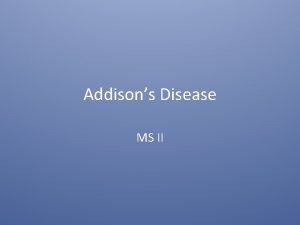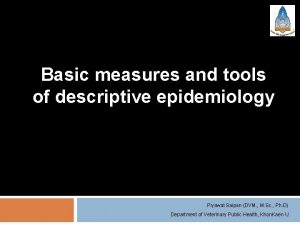Endocrinology Addisons Disease Addisons disease Prevalence 1 in










- Slides: 10

Endocrinology Addison’s Disease

Addison’s disease Prevalence: 1 in 125, 000 First described by Dr Thomas Addison who documented cases caused by tuberculosis. Most common cause now autoimmune in the UK but remains TB worldwide Autoimmune Addison’s usually occurs between age 2050

JFK suffered from both Addison’s and hypothyroidism

Symptoms � Fatigue/weakness � Pigmentation of skin (sun-exposed areas, armpits, nipples, palmar creases, inside mouth, recent scars, pressure points e. g elbows) � Dizziness (from hypotension) � Decreased appetite & weight loss � Occasional nausea & vomiting, abdominal pains � Occasional diarrhoea/constipation � Muscle cramps/pain � Vitiligo � Cravings for salty food or drink � Oligomenorrhoea/amenorrhoea in women � Depression/psychosis/low self-esteem � The unforgiving master of non-specificity and disguise

Consider JFK – - Presented with two episodes of collapse secondary to hypotension as a child - Frequent episodes of abdominal pain and recurrent diarrhoea - Inability to gain weight for much of his life - Diagnosed aged 30 with Addison’s

On examination �Look for cutaneous and mucosal hyperpigmentation �Check blood pressure �Look for evidence of other autoimmune disease

Investigations �FBC, U&Es, LFTs, glucose, calcium �Venous blood gas (may show normal anion gap metabolic acidosis) �Short synacthen test

Management Will depend on the aetiology but typically includes glucocorticoids (hydrocortisone) +/mineralocorticoid (fludrocortisone) replacement

Follow-up �Patient should wear Medic Alert bracelet �Carry steroid card with them �Must ↑ steroids for stenuous activity/illness/injury/stress �Warn patient against abruptly stopping steroids �Should have 100 mg injectable hydrocortisone at home in case of vomiting �Patients must be followed up yearly for BP & U+E checks

Addisonian crisis �Patient may present with; � Hypotension � Severe vomiting and diarrhoea � Pains in the back and abdomen �Dehydration �Collapse (triggered by stresses such as infection/ trauma/ surgery/ insufficient hydrocortisone for strenuous activity)
 What causes addisons disease
What causes addisons disease Period prevalence vs point prevalence
Period prevalence vs point prevalence Period prevalence vs point prevalence
Period prevalence vs point prevalence Prevalence defination
Prevalence defination Period prevalence vs point prevalence
Period prevalence vs point prevalence Endocrinology
Endocrinology Istilah medis sistem endokrin
Istilah medis sistem endokrin 2232021
2232021 Reproductive biology and endocrinology
Reproductive biology and endocrinology Endocrinology of pregnancy
Endocrinology of pregnancy Reproductive endocrinology near campbell
Reproductive endocrinology near campbell

















